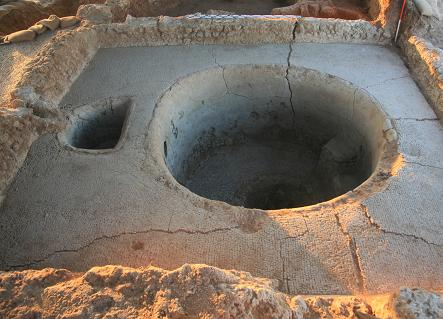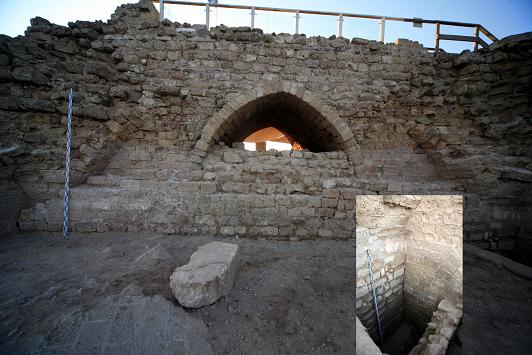Tel Aviv University researchers discovered a Samaritan winepress in the Apollonia-Arshoff excavations

The Apollonia-Arshoff site is located on the northwestern border of Herzliya, on a coastal cliff. Initial excavations at the site were conducted in 1950. From 1977 the site was excavated on behalf of the Antiquities and Museums Department and in 1982 by a delegation from the Institute of Archeology of Tel Aviv University under the direction of Professor Israel Roll; In recent years (Leman 2006), Dr. Oren Tal from the Institute of Archeology of Tel Aviv University has been managing the excavations at the site. From the sixth century BCE, the site was occupied continuously until the Crusader period. From the Persian and Hellenistic periods, sections of thin walls, waste pits and several graves were uncovered. The main architectural find from the Roman Apollonia is a villa facing the sea, with a priestly courtyard, outside of which there is a peripheral corridor and rooms from all sides. In the Byzantine period, Sozusa (Apollonia) spread over a sprawling area of about 280 dunams. Among its findings are a church and industrial quarters with ghettos, textile mills, plastered blessings and furnaces for the production of raw glass. During the time of the Umayyad caliph Abd al-Malak (705-685) Arsuf was surrounded by a wall (about 77 dunams in area). At the end of the period, the settlement became Rabat (Masad), where Muslim religious scholars worked. In 1101 the site fell to the Crusaders. Towards the middle of the twelfth century, the site was given to a noble family among the cross bearers and became the center of a feudal lordship. The construction of the fortress began in 1241 and in 1261 the control of the fortress, the city and the seigniory of Arsour was handed over to the Knights Hospitallers. At the end of the Mamluk siege in 1265, the fortified city and the fort in the north were destroyed, and with their fall the site is still intact to this day.
The current excavation season (July-August 2009), the 19th in number, is the result of a collaboration between Tel Aviv University and a group of researchers from Brown University (led by Professor David B. Cooper), and partially funded by the National Scientific Fund. Brown University researchers were actually responsible for advanced computing means (digital archaeology) for the purpose of documenting the excavations, the remains and the archaeological findings at the site for the purpose of computer simulations and the development of paradigms for the advancement of archaeological research in Israel in particular and in the world in general. Assistance was also received from the Nature and Gardens Authority. Researchers from Israel and abroad participated in the excavations, along with beginning and advanced students from Tel Aviv University, volunteers from Israel and abroad and paid workers.

As part of the current season, five excavation areas have been excavated throughout the site, including remains from different periods, but the highlight is the discovery of Area O in the north of the site, where a large-dimensioned cave (about 9.8 x 7.5 m) was uncovered, paved with mosaic stones, with a dedicatory inscription in the center of its stepping surface In Greek, it means "One and only God, help Cassianus together with his wife, and his children and everyone." The wording of the inscription and the findings discovered in the excavations hint at Samaritan ownership of the complex in the Byzantine period (fifth-sixth centuries CE). Although the inscription was revealed already in the previous season of excavations (August 2006), only now will we be able to know precisely what was the architectural complex in which it was used. Dedication inscriptions of this type are known mainly from Samaritan religious buildings (synagogues) and it is not impossible that the get we uncovered was incorporated into a public building that may have had ritual activity. The fermentation pit in Vat (approx. 3 m in diameter and approx. 2.25 m in depth; Figure 1) is one of the largest that has been uncovered in Israel, and there is archaeological evidence that was uncovered in the excavation that establishes the cessation of its activity in the first half of the 6th century AD (it is possible that in the context of the Samaritan revolt [ 529 AD]). It is interesting to note that the gate was damaged by an earthquake (probably in 749 CE), that is, after it was out of use. 25 undergraduate students of the Department of Archeology and Ancient Near Eastern Cultures of Tel Aviv University participated in the excavation of the Geth, which was an educational excavation and an enjoyable experience for them.
In the area of the Crusader fortress (Area F), which is actually the most impressive architectural complex on the site, the excavations were concentrated in its western part, against the coastal cliff (Figure 2), in order to expose underground complexes and ease the dirt loads on the cliff for the benefit of future regulation of rainwater drainage. The excavations revealed a part of an underground hall in the west of the fort that has not yet been fully uncovered, but it was evidently used for a secondary purpose after the destruction of the fort in 1265. The excavations in the fort are a direct continuation of the declaration of the site as a national park (Apollonia National Park) in 2001, recognizing it as one of the hundred world heritage sites in danger of extinction on by the World Monuments Fund in 2004, and its inclusion in the tentative list of Crusader fortresses that are World Heritage by UNESCO in 2006.
In area R, in the center of the site, the uncovering of a large building began, in one of whose rooms a white mosaic floor was discovered, but we have not yet been able to date the building with certainty. In any case, the opening of the area was determined thanks to the marking of a large vault in the site plan drawn by the British surveyors (at the end of the 19th century), and we intend to continue digging in the place.
In area L, the southeast corner tower of the Crusader lower city wall, the array of fortifications from the Crusader period and from the early Arab period was exposed one on top of the other, both of which were actually built on architectural remains from the Byzantine period.
In area M, in the south of the site, the excavation area (up to virgin soil) was completed, which was opened in the previous excavation season (August 2006), where a large waste pit from the sixth-seventh centuries AD was discovered, while in the current season we actually completed the exposure of a cache of bronze coins From the fourth-fifth centuries CE.
The results of the last season's excavations allow a better understanding of the site throughout all its periods of existence and the settlement and social history of the early Byzantine and late Crusader periods.
